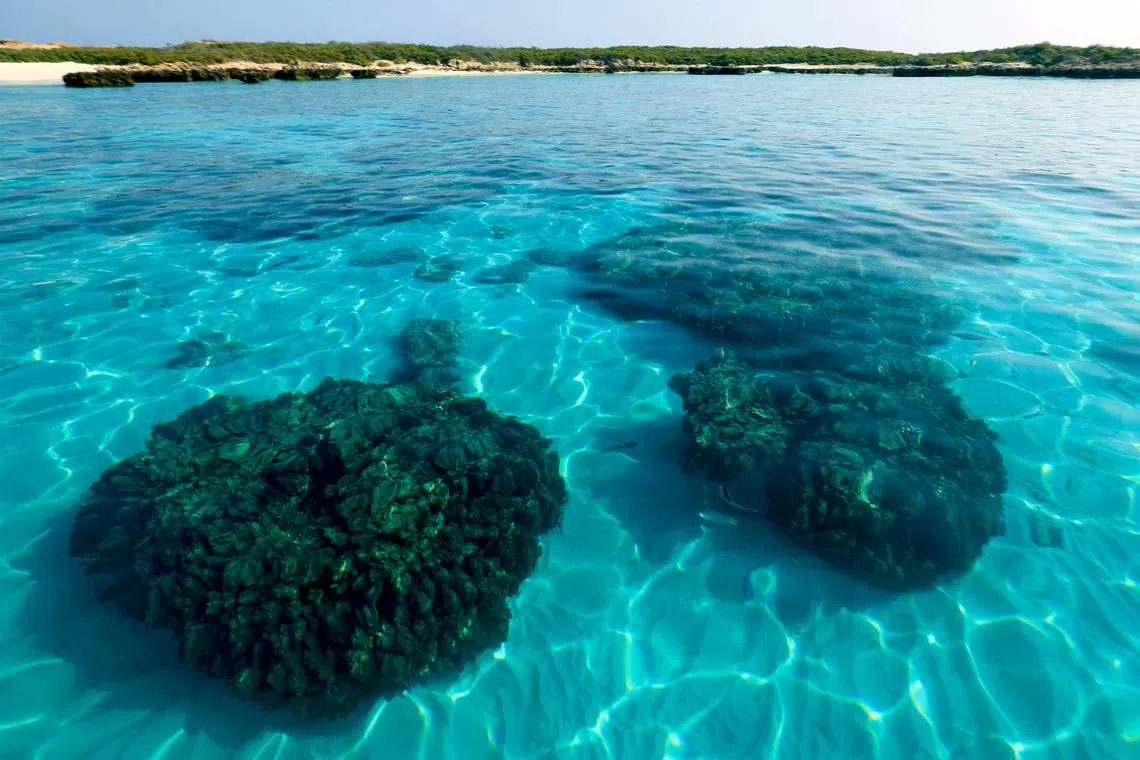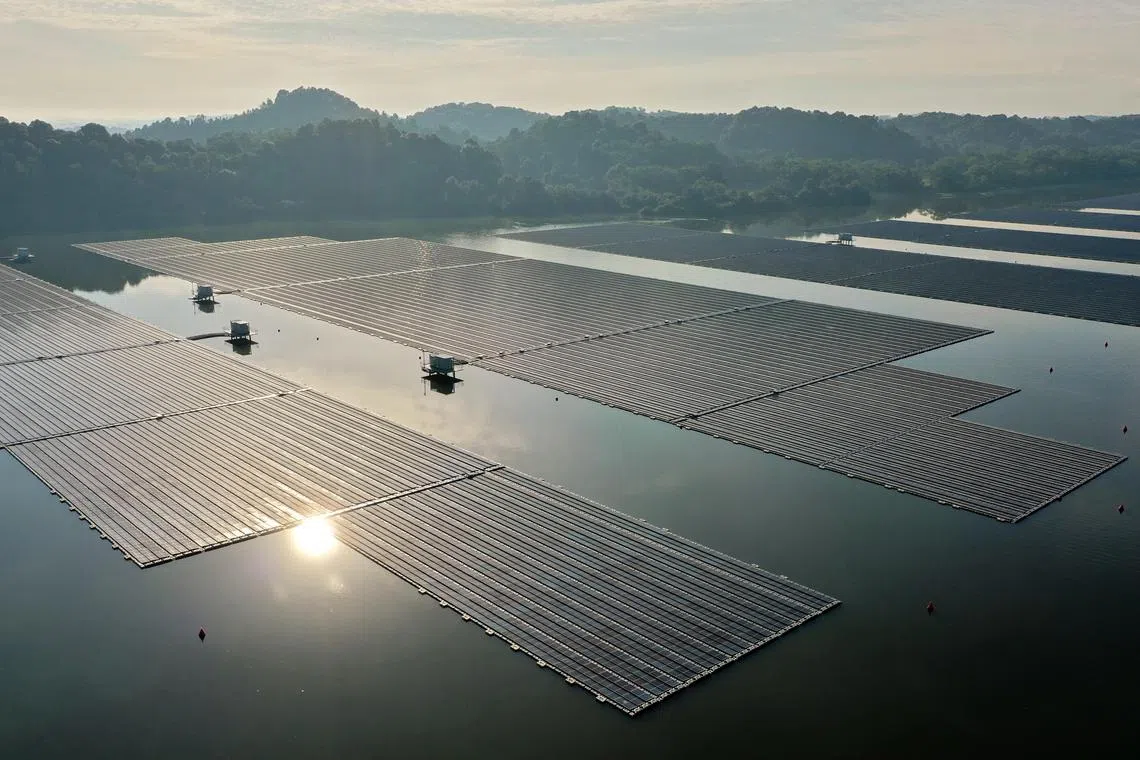Commentary
The ripple effect of investing in sustainable oceans
Sign up now: Get ST's newsletters delivered to your inbox

The ocean featured prominently at the recent COP28 climate summit, given ocean solutions are critical to fighting climate change.
PHOTO: AFP
Janet Shum
Follow topic:
Coastal communities are among the most vulnerable to the effects of climate change.
Singapore’s Integrated Urban Coastal Management framework and recent announcement of technical studies for the multi-functional “Long Island” reclamation project
Globally, the ocean featured prominently at the recent COP28 climate summit, given that ocean solutions are critical to fighting climate change.
Policy, innovation and data enhancement continue to drive the blue economy – industries that sustainably utilise and contribute to marine ecosystem conservation for human benefit in a manner that maintains all ocean resources over time – which is worth between US$3 trillion (S$4 trillion) and US$6 trillion per year.
The potential impact of investing in the blue economy is much broader than just contributing to life below water, and it is imperative to building a climate-resilient, prosperous and sustainable future.
Why does a sustainable ocean matter?
The ocean produces 50 per cent to 80 per cent of the oxygen we breathe, absorbs 90 per cent of excess heat, and is our biggest natural carbon sink, capturing 30 per cent to 70 per cent of global carbon dioxide produced.
At the same time, ocean industries provide millions of job opportunities, and approximately 40 per cent of the world’s population depend on marine and coastal biodiversity for their livelihoods and part of their animal protein intake.
Pressures on the ocean and the ecosystem services it provides have increased significantly due to pollution, over-exploitation and seascape change alongside climate change.
Citi’s recent research shows that just 13 per cent of the world’s oceans remains untouched by the negative impact of human activities, and an estimated US$27 trillion of marine- and land-based business revenue could be indirectly at risk.
Ocean action is not merely an option, it is our lifeline.
Putting the ocean first
Last year’s World Oceans Day’s theme “Planet Ocean: Tides are Changing” not only highlights the interconnected economic, environmental and social significance of the ocean, but also emphasises the collective need to put the ocean first.
The ocean is one of our most important ecosystems, yet United Nations Sustainable Development Goal 14: Life Below Water is among the least-funded sustainable goals. Recent estimates suggest that US$175 billion to US$459 billion in funding is needed per year for a sustainable ocean.
While the public sector and donor communities have been playing a critical role in preserving the ocean, there is still much work to do, given the pace and scale of declining ocean health, and private sector capital can play a catalytic role in addressing the funding gap.
Accelerating ocean actions around the world
Leaders around the world increasingly recognise our dependence and impact on the ocean. Oceans are one of the four key nature realms of the Taskforce on Nature-Related Financial Disclosures framework, a globally recognised framework established to factor nature into financial and business decisions.
We see global calls for renewed vigour in ocean protection via various encouraging initiatives, including the Ocean Action in 2023 statement, the creation of a Universal Declaration of Ocean Rights and the Global Plastics Treaty which aims to end plastic pollution.
At the recent COP28 with the largest ocean pavilion to date, key positive commitments around sustainable oceans included the Joint Declaration on Ocean and Climate Action which urges countries to consider ocean-based actions in their national climate goals and sustainably manage 100 per cent of the ocean under national jurisdictions.
This declaration complements the world’s first “Treaty of the High Seas”
There were more than 50 announcements towards decarbonising shipping under the Green Shipping Challenge. At the COP28 Singapore Pavilion, there was a signing of a memorandum of understanding between Pacific International Lines and DP World
Moreover, 21 countries formally endorsed the Mangrove Breakthrough to protect and restore 15 million ha of mangroves globally by 2030. The International Blue Carbon Institute, launched in Singapore in 2022,
In Singapore, numerous steps have also been taken to strengthen its marine and coastal protection and blue economy alongside its Green Plan 2030,
An ocean of opportunities for investors
The blue economy continues to expand, buoyed by the above myriad of enabling factors.
Investors can consider taking a holistic approach by:
divesting from harmful and unsustainable activities;
assessing ocean-related risks to the value of their portfolios;
steering more funds into sustainable ocean projects and businesses to diversify their portfolios; and
engaging with companies, fellow investors and policymakers to support the transition.
Investors can find opportunities in diverse sectors within the blue economy, ranging from transport, fisheries, aquaculture, energy, biotechnology, tourism, ecosystem management, waste and water management to the circular economy.
An example of a scaleable marine renewable energy solution is the 5MW-peak system floating solar farm installation in Singapore, one of the world’s largest, which can offset over 4,000 tonnes of carbon dioxide a year.
There is a variety of financial strategies in both the public and private markets to enable investors to support the blue economy, such as thematic ocean indexes or funds, blue bonds, ocean impact investment funds, direct private investments and blended finance vehicles.

Investors can find opportunities in diverse sectors within the blue economy, such as in scaleable marine renewable energy solutions like the 5MW-peak system flowing solar farm installation in Singapore, says the writer.
PHOTO: ST FILE
Interconnectedness of ocean solutions and sustainable development goals
Investing in the blue economy is more relevant than ever before, and it opens up new opportunities for the broader sustainability agenda.
Research by the Ocean Panel indicates that US$1 invested in key ocean actions can yield at least US$5 in global benefits
We believe blue investments can enable investors to mitigate material risks and seek competitive risk-adjusted returns alongside positive sustainability objectives, from enhancing climate resilience, improving food security, advancing equality and spurring economic growth, to providing good health and well-being.
For example, investments into sustainable aquaculture can contribute to multiple sustainable development areas. This not only helps to tackle overfishing and protect ocean habitats and species by transforming the industry, but also supports food security and provides employment and livelihoods, which have follow-on contributions to end poverty and reduce inequalities.
Artificial intelligence-driven models that estimate the productivity of aqua farms can also enable financial inclusion as banks are able to use the data to identify higher-quality small fisheries, which previously had no access to credit or formal financial history.
There is an acceleration of global demand and industrialisation of seaweed due to its potential as a good source of food and nutrients, as an ingredient used for plant-based shrimp, for instance, as well as for biofuel and as cattle feed for methane reduction.
Research shows that the global seaweed cultivation market is worth around US$17 billion and is estimated to nearly double by 2025. Asia is the largest seaweed production region, accounting for about 97 per cent of global production in 2019.
The oceans have been under-researched and there is an urgent need to unlock ocean data via emerging real-time ocean data monitoring systems, which can benefit a wide range of stakeholders.
These new technologies can enable scientists to better understand ocean conditions and protect endangered species, allow governments to monitor fisheries and adherence to regulations, and equip meteorologists to better predict and prepare for extreme weather events.
Our ocean health has reached a tipping point. Let’s turn the tide and put our capital and resources at work in a sustainable ocean, which generates myriad business opportunities with the ripple effect not just on profits, but also on our planet and people.
The writer is Citi Global Wealth’s sustainable investing specialist for the Asia-Pacific.

